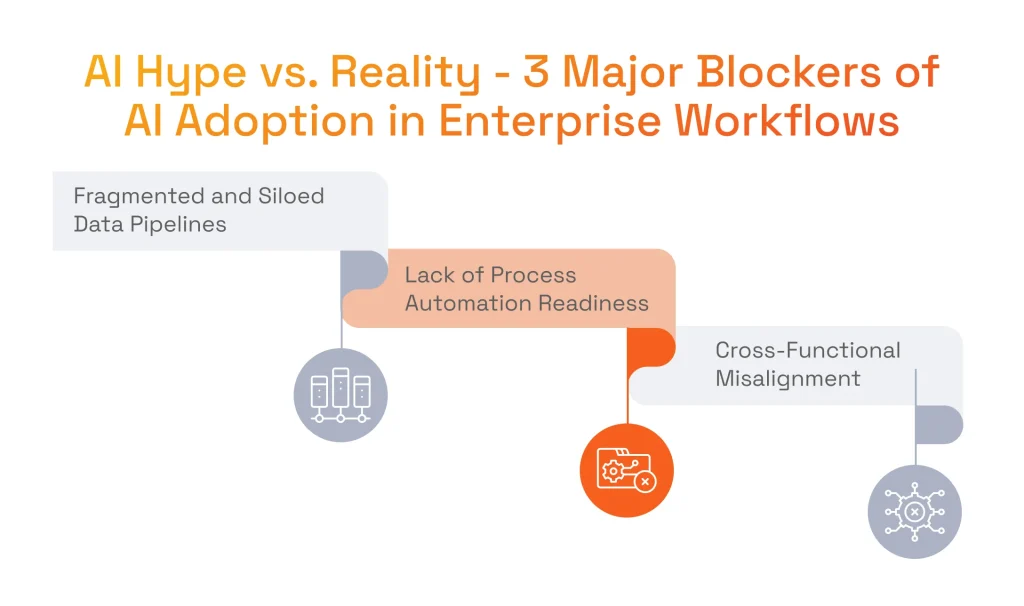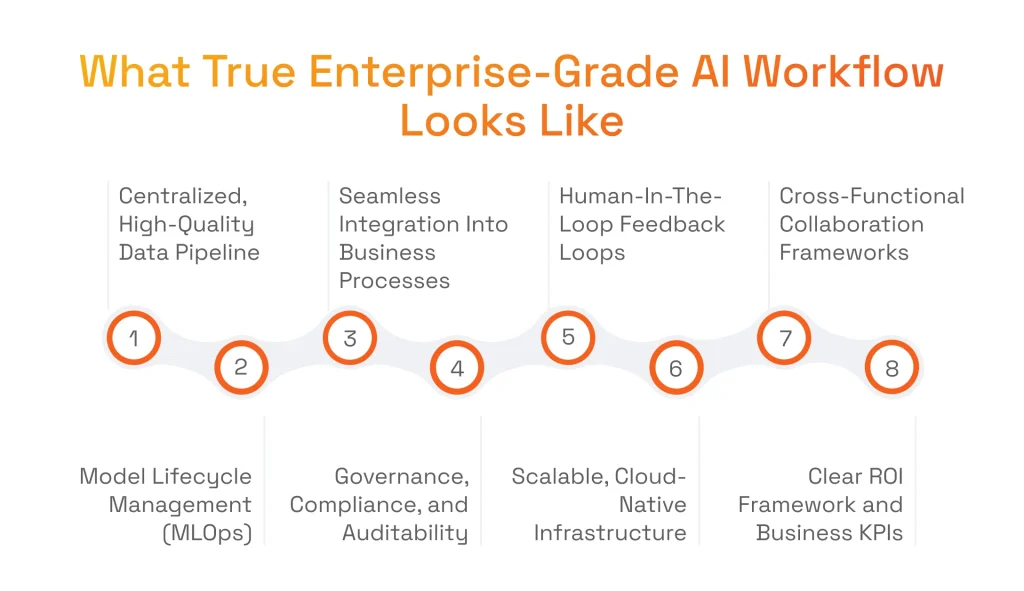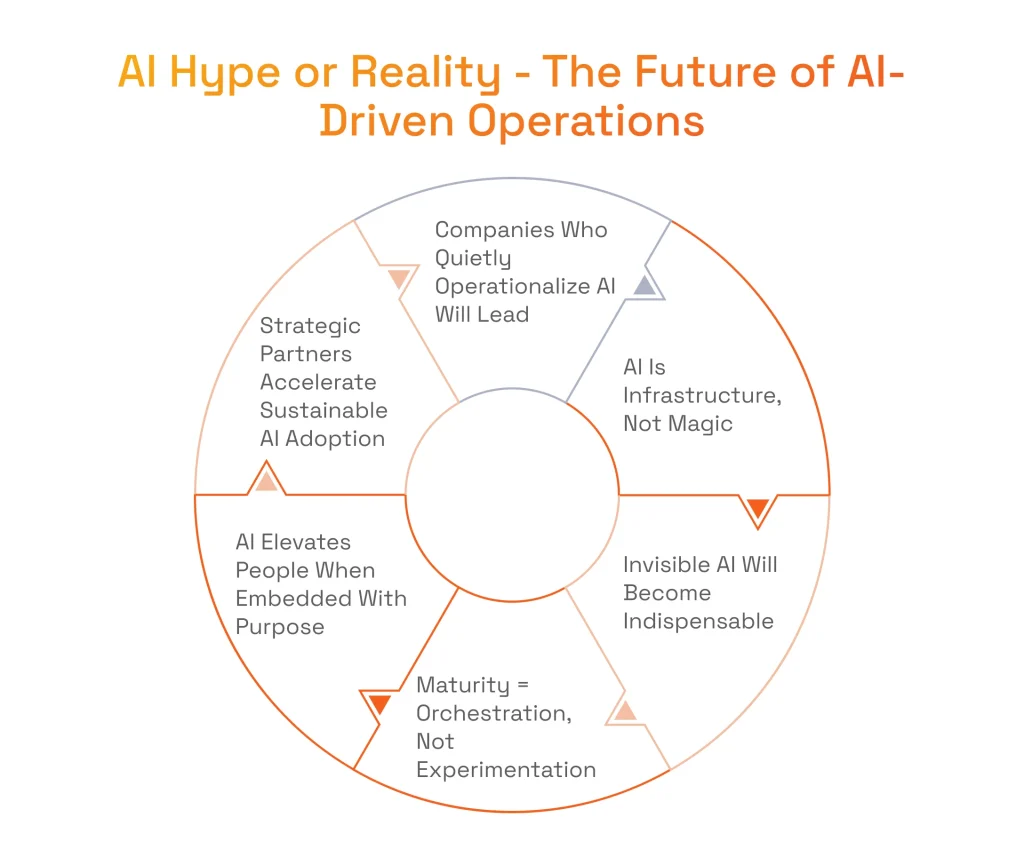According to Statista, the Artificial Intelligence market is projected to reach an astonishing USD 244.22 billion by 2025, indicating that AI hype is apparently bigger than ever. We are all aware of impressive use cases of generative AI, from generating complex texts in mere seconds and designing beautiful images to summarizing sophisticated documents and creating meaningful chatbot responses. Undoubtedly, those are very useful tasks, but they barely scratch the surface of what large businesses and enterprises need from the technology, as there are specific demands for complex integrations and strict data governance requirements.
Exploding Topics reports that 78% of global companies currently use AI. At the same time, the majority of enterprises don’t require the most cutting-edge solutions, but rather ones that are custom-tailored to their needs. The future is all about the smartest integrations for improving essential workflows and boosting the capabilities of human employees.
However, there is a massive gap between Artificial Intelligence hype and operational readiness. Businesses should focus on enabling solutions by identifying precise business pain points that AI can address, building modular and scalable architectures, investing in data quality, and training teams to work alongside AI.
In this article, we will talk about AI getting so popular and practical implementations that deliver actual business value.
The AI Hype Is Loud – But What’s Being Left Out of the Conversation?
Nowadays, the line between Artificial Intelligence hype and reality is more blurred than ever. If AltIndex is to be believed, in 2025, we should expect 378 million global users of AI. The technology covers everything from processing social media feeds for marketers to complex RPA development projects for industrial leaders.
The promise looks to be limitless, with fully automated operations, close-to-instant insights, and 24/7 possibilities for customer interaction. The reality, however, is more grounded, since behind the massive Artificial Intelligence hype are narrow and practical use cases. So, what can AI actually do today versus what’s just hype? It can add measurable value across a wide range of use cases that can be implemented without enormous budgets or complete technical overhauls for organizations. The list of realistic implementations of Large Language Models (LLMs) alone includes:
- Generating marketing texts, tailored for a specific customer base and the goals of a specific campaign.
- Summarizing and transcribing large documents and transcripts saves hours of manual labor.
- Auto-tagging and routing support tickets based on the understanding of natural language.
- Personalizing email campaigns based on behavioral triggers like purchase history or clicks.
- Extracting structured data from scanned forms or invoices, eliminating the risk of manual error.
It is easy to see value in these use cases because they easily fit into existing workflows without the need to rebuild an organization and replace legacy systems. These cases help companies operate more effectively overnight, truly capitalizing on the human–in-the-loop approach.
Why is there so much hype around generative AI, then? It exists because the solutions created with the help of generative AI development services still have some kind of magical aura. Everyone can experience generative AI directly, regardless of their technical background. Watching AI create an astonishing image from a text description creates an illusion of accurate intelligence and capability.
Serhii Leleko
ML & AI Engineer at SPD Technology
“The abovementioned tools can excel in strictly controlled environments and creative contexts. Actual application in regulated and truly high-stakes enterprise environments is a much more complex initiative. So, this is where the disconnect appears. There is a lot of promise to transform everything from customer service to critical operations, but beneath the hype cycle for Artificial Intelligence is the fact that core operational conditions determine whether AI can work in a setting of a certain organization.”
Here what’s often being left out of the public conversation about the implementation of the technology:
- AI Success Depends More on Workflow Readiness Than Model Accuracy: Even the most powerful models will fail if they don’t align with the way internal teams operate and data flows that exist inside an organization.
- Most Organizations Don’t Have the Infrastructure to Support Continuous Learning: AI/ML models require regular fine-tuning and training on clean data while establishing feedback loops to remain effective.
- Talent Misalignment Slows Down Adoption: Unfortunately, a lot of companies still have data silos which is bad news for AI, as seamless collaboration between technical, operational and business teams is required for successful adoption.
- Business Leaders Aren’t Always Clear on AI’s Limitations: There is a common misconception that AI is used for autonomous decision-making in a business context, and not smart augmentation.
- PoC’s Are Not Proof of Readiness: Unfortunately, a successful demo does not guarantee effective system integration, compliance, and scalability of the solution.
Want to learn how to leverage AI for business intelligence?
Read our featured article to discover winning BI enablement solutions!
AI Hype vs. Reality – 3 Major Blockers of AI Adoption in Enterprise Workflows
One of the problems with AI hype is that solutions are often presented as plug-and-play tools aimed at transforming businesses overnight.

However, actual enablers of the technology quickly find out that building and scaling AI models for intelligent automation is much more complex than deploying a model. The nature of the roadblocks encompasses technical, systemic, and operational aspects, as they are all tied to the organization’s structure. Let’s discuss the three most common critical blockers for enterprise adoption of innovation that hype around AI (Artificial Intelligence) is typically silent about.
Fragmented and Siloed Data Pipelines
The success of any AI initiative is closely connected to the quality, quantity, and availability of data. Unfortunately, most enterprises’ tech stacks were built without the potential for AI integrations in mind. It is common that data is scattered across entirely different departments, buried in legacy systems, and organized for reporting needs, and not for real-time decision-making. This fragmentation creates blind spots and bottlenecks.
For AI solutions to work at scale, there is a need for centralized and high-quality data, which many organizations lack due to outdated architectures that can’t support the ingestion, transformation, or feedback loops required for modern machine learning. Without unified data pipelines, ML models are limited to narrow use cases or quickly become outdated, missing the performance heights that AI hype promises.
So, using data analytics services and investing in real-time, centralized data infrastructure is not just another technical upgrade, but rather a mandatory requirement for enterprise AI.
Lack of Process Automation Readiness
Another common mistake is to drop AI into workflows that were never designed for automation. Manual handoffs, scattered approvals, and patchwork RPA solutions end up in fragile systems where AI has no clear entry or exit points.
Effective AI systems require clearly defined inputs and outputs with triggers, endpoints, and decision points that are consistent and repeatable. If the organization’s environment is highly manual, there is a certain degree of process unpredictability, which makes meaningful integration of AI difficult.
Serhii Leleko
ML & AI Engineer at SPD Technology
“It is important to note that the overall automation maturity should precede or at least accompany investments in AI initiatives. When all critical workflows are digitized, orchestrated, and well-documented, AI can be introduced with far less friction. Otherwise, organizations risk building intelligent tools that are disconnected from the reality of how work actually gets done.”
Cross-Functional Misalignment
Even the simplest AI projects don’t belong to a single, isolated team as they exist at the intersection of data science, engineering, operations, and business strategy. Many organizations, however, have these groups in silos, each with its own goals, timelines and KPIs.
This is one of the main reasons why Proof-of-Concepts (PoCs) add to negative Artificial Intelligence hype vs. reality, as these projects stall out. At the same time, data science teams may build exceptional ML models, but without proper support from engineering teams, the models never reach their actual deployment. Business teams, on the other hand, may demand ROI, but without clear integration paths, that value remains theoretical.
The pivotal element in transitioning from experimental to operational AI is structured collaboration, which encompasses shared ownership, clear metrics for success, and end-to-end visibility across all stakeholders. It is possible to achieve that by using AI consulting services before making investments in innovative projects.
When it comes to practice, where is the clear line between AI hype or reality? Companies that leverage AI demand forecasting know that technology is already a decisive market advantage. Read our article and find out why!
What True Enterprise-Grade AI Workflow Looks Like
For some, AI is just hype, experimental cases, and flashy demos, but successful businesses focus on the outcomes that matter. It’s all about creating a comprehensive, production-grade solution that can scale up and down easily, fully meeting real-world business needs and delivering tangible results. Let’s merge AI hype and reality by looking at how actual workflows should operate in enterprise-grade environments.

1. Centralized, High-Quality Data Pipeline
Clean, consistent, and accessible data is the basis of AI solutions. To work to its fullest potential in enterprise environments, a well-governed data pipeline is needed. It is possible to gain by leveraging ETL/ELT tools to ingest and transform data into a centralized warehouse or lakehouse. When done right, every AI/ML model will be trained on reliable and up-to-date information.
2. Model Lifecycle Management (ML Ops)
Training models, however, is just the beginning because truly mature systems that deliver on reality vs. AI hype can support the full model lifecycle. It includes features like version control, automated retraining, performance tracking, CI/CD for model deployment, and rollback mechanisms. Without proper MLOps, models degrade or drift unnoticed, and experimentation can’t scale into production.
3. Seamless Integration Into Business Processes
Predictions are the most valuable when they result in action. Business workflows should be directly connected to AI solutions, rather than operating in isolation. Whether it’s providing insights through intuitive dashboards, automating user-facing responses, or enhancing operational tools, hype between AI and reality can lead to increased effectiveness for organizations.
4. Governance, Compliance, and Auditability
In highly regulated industries, for example, when implementing AI in fintech or healthcare, the companies are required to create additional layers of security, explainability, and compliance. To match enterprise workflows, AI solutions should have full traceability, including access control, audit logs, explainability frameworks, and adherence to standards such as GDPR, SOC 2, or ISO/IEC 27001.
5. Human-in-the-Loop Feedback Loops
Whether AI hype or reality, the middle ground is that even the most advanced ML models still require human expert involvement for exceptional results. A production-grade AI system should support human-in-the-loop review, enabling experts to correct, validate, or override outputs, thereby feeding valuable data back into retraining cycles to reduce bias and enhance performance.
6. Scalable, Cloud-Native Infrastructure
From training at scale to serving ML models globally, infrastructure must be elastic and cloud-native. Container orchestration tools, such as Kubernetes or ECS, enable repeatable deployments and high availability, while cloud computing scales on demand.
Here at SPD Technology, we have firsthand experience in combining cloud and AI capabilities. One of the prime examples of this is the partnership with Morningstar, in which we successfully scaled their platform. As a result, we achieved a 10x reduction in data storage costs and significantly optimized data processing time.
7. Cross-Functional Collaboration Frameworks
AI is hype instead of becoming an organization-wide success when there is no cross-team alignment in place. There should be practical shared tools, workflows, and ownership models for data scientists, engineers, and compliance officers. Without this, even the best models stay stuck in pilot mode.
8. Clear ROI Framework and Business KPIs
Lastly, but not least, AI initiatives should be focused on achieving clear business outcomes above all else, whether it’s reduced costs, higher efficiency, or improved customer experience. Clear KPIs are the only justification for large-scale production deployment.
AI Hype or Reality – What Is the Future of AI-Driven Operations
We live during the Gen AI hype cycle, when the world is fascinated by the technology’s capabilities, from code assistance to the generation of complex texts. However, the gap between AI hype and reality is growing wider for many organizations, as they continue to struggle with translating experimentation into business value.

Here, at SPD Technology, we work on state-of-the-art projects for our global clients, and can see where the progress of technology is heading:
- The future belongs to companies that quietly operationalize AI: While loud announcements and flashy prototypes may look good, actual needle movers gain their decisive competitive advantage by implementing AI into their daily operations. Those who treat AI as part of their critical infrastructure reap the actual benefits, allowing value to compound quietly and consistently over time.
- AI isn’t magic—it’s infrastructure, alignment, iteration, and resilience: Unfortunately, as a fact of AI hype vs. reality, the technology doesn’t deliver results on its own. Success depends on the wise execution of basic elements such as clean, connected data, fast feedback loops, aligned teams, and the discipline to iterate.
- Enterprise leaders will differentiate by embedding AI into operations: True market leaders will not build the most models, but rather shine in the fruitful integration of AI. They’ll design workflows where AI insights trigger real actions, creating systems where intelligence is ever-present but not disruptive.
- AI maturity will separate future-ready enterprises from those stuck in pilot purgatory: Many companies remain trapped in endless proofs of concept that never scale. Future-ready enterprises will break through by shifting from experimentation to orchestration, where AI becomes a repeatable, governed part of how business is run.
- AI won’t replace people—it will elevate them, when integrated with purpose: Despite widespread concern, the jobs of the most essential human employees will be safe, as AI will help them to focus on what matters the most. The automation of repetitive tasks enables people to concentrate on creativity and develop robust strategies without unnecessary distractions.
- The wisest choice is to partner with an AI enablement and development vendor: Even among the biggest enterprises, few have internal teams capable of handling the full scope of AI deployment. Especially when integration, such as AI and IoT, is required, and for some industries, like manufacturing, it is mandatory. Multiple AI hype cycles may come and go, but the demand for proven software development vendors capable of handling everything from infrastructure design to data governance will remain.
Want to learn more about interesting use cases of AI and IoT across various industries?
Read our featured article to discover innovative use cases!
Conclusion
There is a lot of hype around AI and reality in the media, with the promises of instant transformation or doubts about the effectiveness. The truth is, custom AI solutions are already delivering measurable outcomes and long-term value for the global leaders without much unnecessary noise.
Successful companies partner with proven AI development services vendors to determine how to leverage the technology’s potential and deliver performance tailored to a specific situation. Here at SPD Technology, we are fully committed to this, as our clients in entirely different industries receive grounded and tailored solutions for their business cases. We differentiate between true AI innovation and marketing spin by providing tangible value to our clients. Contact us to discover how we can enhance your organization’s capabilities.
FAQ
What’s the next hype after AI?
While the future of AI appears very promising, we can expect a new wave of trends to emerge around Artificial General Intelligence, Quantum Computing, and the convergence of AI with spatial computing. All of these technologies have a chance to take the lead in the world of technology. However, most businesses still have real opportunities by mastering AI and ML solutions.
What should businesses believe — AI hype or AI results?
Businesses should always focus on tangible metrics. Technological hype generates attention, but real results move the needle with boosted efficiency, additional revenue streams, and reduced operational costs. Organizations should definitely remain grounded while implementing innovation and start with pilot projects that deliver measurable KPIs.
How can you separate AI hype from real innovation?
You can distinguish between real AI capabilities and hype by looking at the following indicators:
- Proven use cases that have data that demonstrate ROI.
- Facts that prove successful integration with established systems and workflows.
- Sustainable value over a period of time that impacts the processes of an organization.


